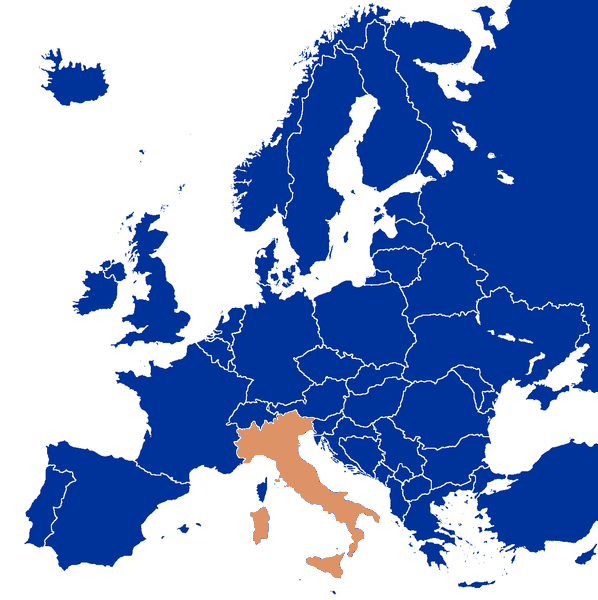Presentation of the Italian Republic

LICEO STATALE "ARTURO ISSEL", Finale Ligure (Sv), Italian Republic
OFFICIAL NAME: Italian Republic
FORM OF GOVERNMENT: Republic
POPULATION: 61,855,120 (July 2015 est.)
AREA : 301,340 sq km
CAPITAL CITY : Rome
OFFICIAL LANGUAGE: Italian
Religion: Christian 80%
Life Expectancy at Birth: 82.12 years
Location: Southern Europe, Italy is a boot-shaped peninsula surrounded by the Mediterranean Sea. Its location has played an important role in its history.
MAJOR MOUNTAIN RANGES: Alps, Apennines
MAJOR RIVERS: Po, Adige, Arno, Tiber
Climate: Predominantly Mediterranean; Alpine in far north; hot, dry in south
Currency: Euro
The sea surrounds Italy, and mountains crisscross the interior, dividing it into regions.There are 20 regions, which are then subdivided into administrative provinces. There are two independent city-states within the borders of Italy: the Vatican State and the Republic of San Marino. San Marino is the world’s oldest republic.
There are dozens of regional dialects that are still widely used throughout the country.
The Alps (with the highest European peak, Mont Blanc, 4810 m.) cut across the top of the country and are streaked with long, thin glacial lakes. From the western end of the Alps, the Apennines mountains stretch south down the entire peninsula. Italy has a huge variety of different and unique landscapes, mountains, sweet green hills, steep cliffs, long sandy beaches and little hidden bays with all the possible nuances of blue and green.
Italy is considered the birthplace of Western civilization and a cultural superpower. Italy was the cradle of the Magna Graecia, the Roman Empire, the Roman Catholic Church, the Renaissance. During its history, the nation gave birth to an enormous number of notable people. Moreover Italy was home to many well-known and influential civilizations, including the Etruscans, the Samnites and the Romans, while also hosting Greek colonies, whose influence and culture had a large impact through the peninsula. The Greek ruins in southern Italy are perhaps the most spectacular and best preserved anywhere.
For more than 2,000 years Italy experienced migrations, invasions and was divided into many independent states until 1861 when it became a nation-state.
The famous elements of Italian culture are its art, music, style, and iconic food. Italy was the birthplace of opera,
The country boasts several world-famous cities. Rome was the ancient capital of the Roman Empire and seat of the Pope of the Catholic Church. Florence was the heart of the Renaissance, Other important cities include Turin, which used to be the capital of Italy, and is now one of the world's great centres of automobile engineering. Milan is the industrial, financial and fashion capital of Italy. Venice, with its intricate canal system, attracts tourists from all over the world especially during the Venetian Carnival and the Biennale.The oldest university in Europe is in Italy – The University of Bologna was founded in 1088 and has been in operation ever since.
Italy is home to the greatest number of UNESCO World Heritage Sites (53) and according to one estimate the country is home to half the world's great art treasures.Overall, the nation has an estimated 100,000 monuments of any sort (churches, cathedrals, archaeological sites, houses and statues).
Economy: Italy has a diversified industrial economy, which is divided into a developed industrial north, dominated by private companies, and a less-developed, welfare-dependent, agricultural south, with higher unemployment. The Italian economy is driven in large part by the manufacture of high-quality consumer goods produced by small and medium-sized enterprises, many of them family owned. Italy also has activities in agriculture, construction, and service sectors.
And, of course the Italian cooking tradition is worldwide famous, with its prestigious wines.
Italy is the third-largest economy in the euro-zone, but it has a high public debt.
The Ligurian region
An untouched corner of Italy, Liguria , known as The Italian Riviera, is the right place for experiencing the authentic Italian living. Liguria is a narrow land squeezed between the mountains and the sea with mild climate, breathtaking views, spectacular cliffs, small fishing villages with tall and slender houses in vivacious colors, secluded bays and hidden art treasures. This is the perfect place to live the Italian “dolce vita” and immerse yourself with its untouched traditions, discover the tastes and scent of an extraordinary cuisine, meet real locals. Experiencing Liguria is outside of the conventional schemes!
The Italian Riviera extends in one direction from France to Genoa along the “Riviera di Ponente” which is home to small untouched and precious villages that are part of “The Most Beautiful Villages in Italy” list. Each town has a story and local people ready to tell it. Wine and olive oil is the quintessence of this part of Liguria. Undiscovered towns and sea resort with something magical that will touch your heart! Up to the Tuscany Border there’s the “Riviera di Levante”, home to the stunning and colored villages of Cinque Terre and Portofino, but also to places you have never known and that have an authentic appeal such as Camogli, Lerici, Tellaro, Sarzana, just to name a few! Liguria is just bringing back home a real part of Italy, charming and undiscovered by the mass tourism at the same time!Map of Europe, license: public domain, source: en.wikipedia
Our Team
Francesca Sini, Lorenza Oliveri (teacher)
Alessio Bracco, Andrea Ruffino, Arianna Mendaro, Carlotta Eberto, Sofia Salmistraro, Valentina Mazzara

